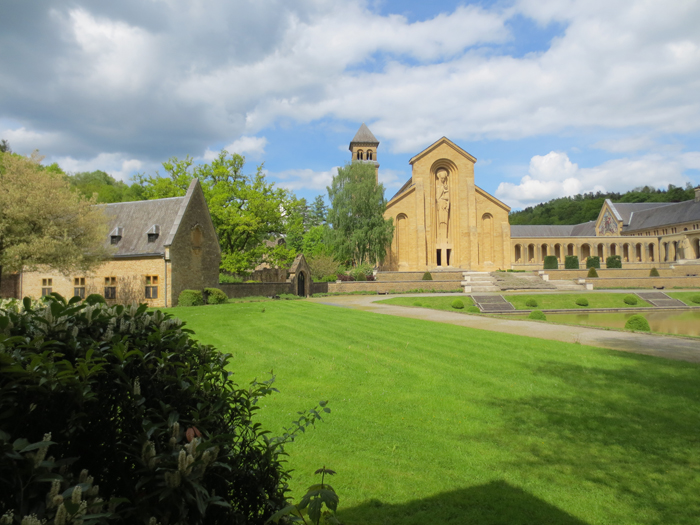Take an armchair visit to a unique brewery, pub or other intoxicating venue that has a story you’ll love.
Orval Brewery and Abbey:
Have you ever thought about joining a monastery? Maybe not, but have you ever thought about visiting a monastery?
Today’s armchair visit takes us to a monastery in Belgium that makes world-class beer – Orval Brewery (or in French: Brasserie d’Orval). Orval Brewery is a Belgian Trappist brewery located within the walls of the Abbaye (Abbey) Notre-Dame d’Orval.
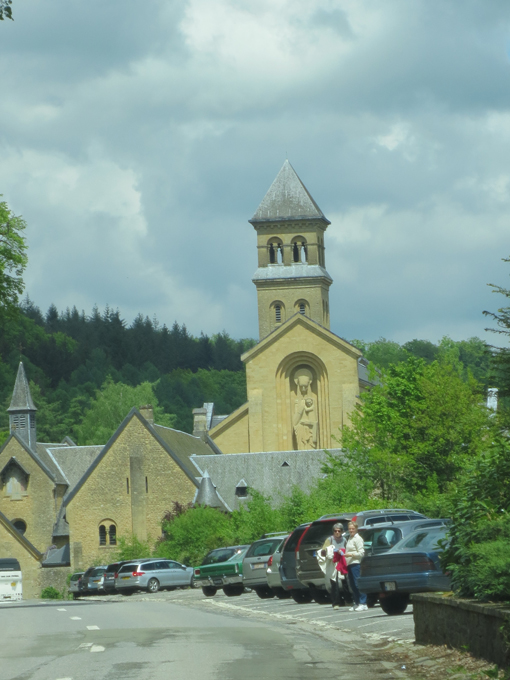 Arriving at Orval Abbey
Arriving at Orval Abbey
Belgium’s Orval Brewery is one of just a handful of Trappist Breweries in the world. The Abbey is a must visit for beer enthusiasts who appreciate this divine brew.
Now a beer can be brewed in an Abbey and not be a Trappist beer. These beers are known as Abbey beers.
So what’s a Trappist beer? In 1997, eight Trappist Abbeys – six from Belgium (Orval, Chimay, Westvleteren, Rochefort, Westmalle and Achel), one from the Netherlands (Koningshoeven) and one from Germany (Mariawald) – founded the International Trappist Association (ITA) to prevent non-Trappist commercial companies from abusing the Trappist name. This private association created a logo that is assigned to goods (cheese, beer, wine, etc.) that respect precise production criteria.
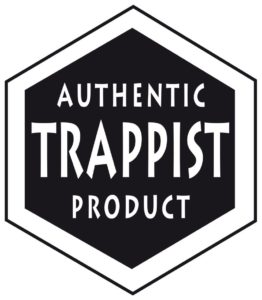 Trappist Logo
Trappist Logo
Specifically, for beers to qualify as Trappist made, the basic criteria are:
1) The beer must be brewed within the walls of a Trappist monastery, either by the monks themselves or under their supervision. The phrase “under their supervision” is key. For example, as noted by Orval Brewery, their “monks have never been directly involved in the production of beer…four brethren (monks) with the Abbot as president are actually well involved in the Board of Orval brewery, with three independent members involved in all decisions. A brother is present every day in the business.”
2) The brewery must be of secondary importance within the monastery and it should witness to the business practices proper to a monastic way of life.
3) The brewery is not intended to be a profit-making venture. The income covers the living expenses of the monks, brewery operating costs, and the maintenance or expansion of the buildings and grounds. Whatever remains is donated to charity for social work and to help persons in need.
4) Trappist breweries are constantly monitored to assure the irreproachable quality of their beers.
Further, the ITA has a legal standing, and its logo gives the consumer some information and guarantees about the product. Today, there are fourteen abbeys which are members of the International Trappist Association that brew and sell their own beer.
Our Visit
Orval Abbey is in the southeast corner of Belgium near the border to France known as the Gaume region. One of the reasons my wife and I always wanted to visit Orval was because they have incredibly beautiful grounds and old Abbey ruins that tourists can visit for a modest fee. Tourists cannot visit the modern Abbey grounds used by the monks of today but can get a peek. Orval Abbey also has a gift shop where you can buy beer, cheese, postcards, and many other gift items. Orval’s brewery is not open to the general public, except during an annual event in September which lasts only two days.
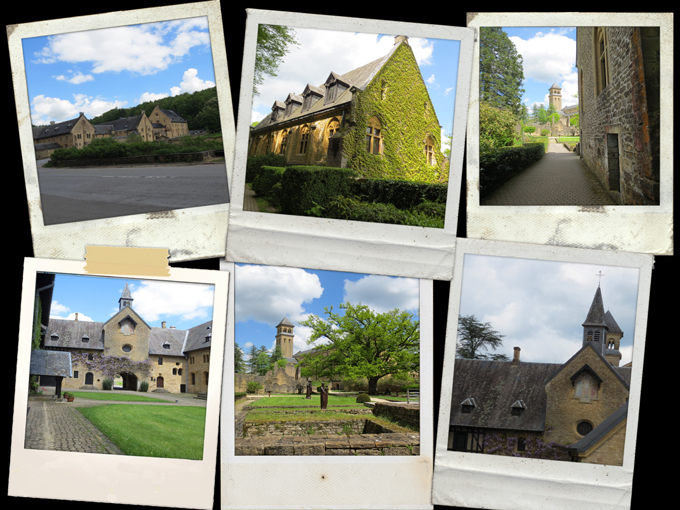 Orval Brewery was not accessible but we could visit parts of the abbey.
Orval Brewery was not accessible but we could visit parts of the abbey.
Located within the confines of the Abbey, Orval’s production brewery started operations in 1931. The brewery was needed to generate funds to support the construction of a new and expanded Abbey. The first master brewer at Orval was a German by the name of Mr. Pappenheimer. The origins of Orval’s very distinctive beer can probably be attributed jointly to Mr. Pappenheimer and to the Belgians, Honoré Van Zande and John Vanhuele, who were working in the brewery at the same period. Today, Ms. Anne-Françoise Pypaert, Brewing Engineer, has taken over the duties of Brewmaster for Orval Brewery and is the very first woman head brewer for Trappist beer.
My wife and I visited Orval Abbey in 2013 and were enthralled. As the two of us walked the open grounds and Abbey ruins at Orval, we were quickly immersed in tranquility. The ruins were from buildings that dated as far back as the 1100’s and yet the site was alive with beautiful ornate architecture that still spoke of the monks’ spiritual devotion and the activities of their daily lives.
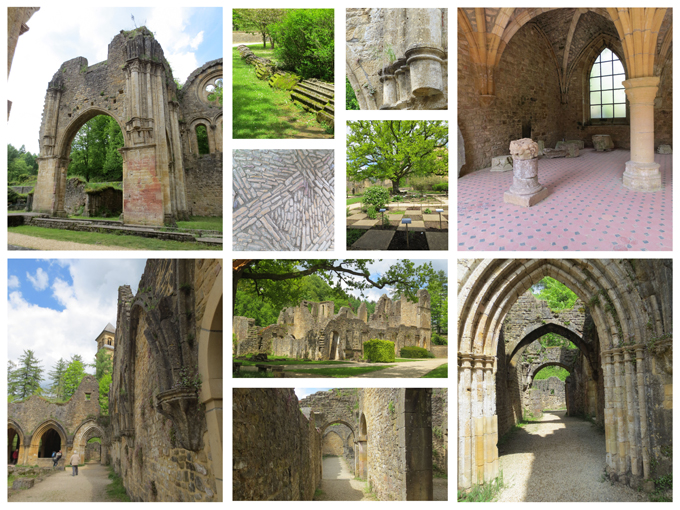 Visiting the Abbey ruins at Orval
Visiting the Abbey ruins at Orval
Of course, I also wanted to visit because of Orval’s unique, delicious beer. Orval Brewery only makes two beers – one for sales and one for the monks’ consumption. The beer that Orval sells (known as Orval Trappist Ale) is actually a higher alcohol version (6.2% ABV) of the beer that has traditionally been consumed by Orval monks (commonly known as Petit Orval or ‘green’ Orval and with an ABV of 3.5-4.2%).
Orval Trappist Ale is a Belgian Pale Ale and is readily found in the United States. Orval also makes some delicious cheeses. There is a café, called A l’Ange Gardien (The Guardian Angel), just outside the abbey where you can eat lunch while enjoying Orval beer. Most importantly, this cafe is also the only location where you can get Petit Orval (served on tap).
Orval Trappist Ale has a beautiful amber-orange color with a slight haze and a magnificent white head. The aroma is of flowers and lemony citrus. The beer is crisp and clean on the palate and flavors of lemon and hay abound. There is a wonderful tartness and hop bitterness and the beer finishes exquisitely dry.
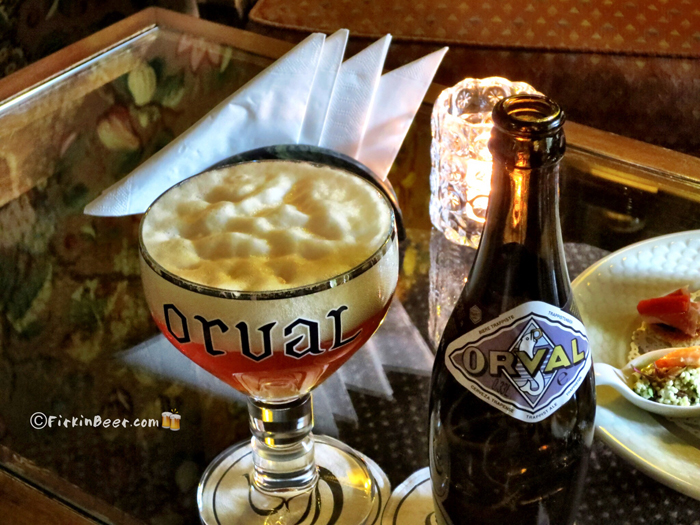 Orval Trappist Ale
Orval Trappist Ale
As noted by Orval, “Throughout the long history of Orval, there has probably always been a brewery at the monastery. Various facts corroborate this idea : topographical references on old drawings; a detailed description of production left by a Franciscan visitor three hundred years ago; an area called the “hop-field” very close to the monastery. To brew beer was customary in these areas little-suited to vine-growing. Beer was first and foremost considered for its nourishing properties : it was called “liquid bread”.”
Our visit to Orval Abbey was breathtaking. I hope you enjoy the photographs. I can’t wait to visit again!
